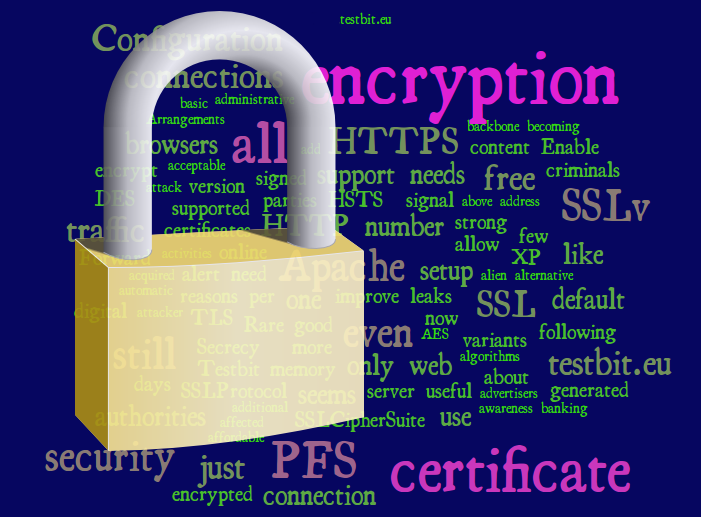
The basic need to encrypt digital communication seems to be becoming common sense lately. It probably results from increased public awareness about the number of parties involved in providing the systems required (ISPs, backbone providers, carriers, sysadmins) and the number of parties these days taking an interest in digital communications and activities (advertisers, criminals, state authorities, voyeurs, …). How much to encrypt and to what extend seems to be harder to grasp though.
Default Encryption
A lot of reasons exist why it’s useful to switch to encryption of content and all data transfers by default (Ed). This has been covered elsewhere in more depth, just a very quick summary could be the following:
-
Not encrypting leads to exposing all online behavior to super easy surveillance by local, foreign and alien authorities, criminals or nosy operators.
-
Rare use of encryption makes it effectively an alert signal for sensitive messages (e.g. online banking) and an alert signal for interesting personalities (e.g. movement organizers).
Forward Secrecy
Even with good certificates in place and strong encryption algorithms like AES, there’re good reasons to enable use of perfect forward secrecy (PFS) for encrypted connections. One is that PFS means each connection uses a securely generated, separate new encryption key, so that recordings of the connection traffic cannot be decyphered in the future when the server certificate is acquired by an attacker. For the same reason PFS is also useful to mitigate security issues like heartbleed, since the vast majority of generated connection keys are not affected by occasional memory leaks, in contrast to the permanent server certificate that is likely to be exposed by even rare memory leaks.
HTTPS On Subdomains
I investigated the administrative side of things for default encryption of all testbit.eu traffic, which also hosts other sites like rapicorn.org. It turned out a number of measures need to be taken to yield an even mildly acceptable result:
-
Many browsers out there still only support encrypted HTTPS connections to just one virtual host per IP address (SSL & vhosts).
-
The affordable (or free) certificates signed by certificate authorities usually just allow one subdomain per certificate (e.g. a free StartSSL certificate covers just
www.example.comandexample.com).
Site Arrangements
So here’s the list of steps I took to improve privacy on testbit.eu:
-
I moved everything that was previously hosted on rapicorn.org or beast.testbit.eu into
testbit.eu/…subdirectories (leaving a bunch of redirects behind). -
Then I obtained a website certificate from startssl.com. I could get my 4096bit certificate signed from them free of charge within a matter of hours. CAcert seems to be the only free alternative, but it’s not supported by major browsers and isn’t even packaged by Debian now.
-
Having the certificate, I setup my apache to a) reject known-to-be-broken encryption SSL/TLS settings; b) allow a few weak encryption variants to still support old XP browsers; c) give preference to strong encryption schemes with perfect-forward-secrecy.
-
Last, I setup automatic redirection for all incoming traffic from HTTP to HTTPS on testbit.eu.
Apache PFS Configuration
The Apache configuration bits for TLS with PFS look like the following:
# SSL version 2 has been widely superseded by version 3 or TLS
SSLProtocol All -SSLv2
# Compression is rarely supported and vulnerable, see CRIME attack
SSLCompression Off
# Preferred Cipher suite selection favoring PFS
SSLCipherSuite EECDH+AESGCM:EDH+AESGCM:HIGH:!MEDIUM:!LOW:!SSLv2:!aNULL:!PSK
# Enable picking ciphers in the above order
SSLHonorCipherOrder onEven stricter variants would be disabling 3DES and SSLv3. But it turns out that IE8 on XP still needs 3DES. Also Firefox-25 on Ubuntu-1304 still needs SSLv3. I still mean to support both for a few more months. This is the stricter configuration:
SSLProtocol All -SSLv3 -SSLv2
SSLCipherSuite EECDH+AESGCM:EDH+AESGCM:HIGH:!MEDIUM:!LOW:!SSLv2:!aNULL:!PSK:!SSLv3:!3DESApache HSTS Configuration
Sites that serve all content via HTTPS, might also decide to enforce secure connections with
HTTP Strict Transport Security (HSTS), a recent security policy mechanism that prevents security downgrades of web connections and hijacking of web sessions.
Apache needs the headers module enabled and a simple configuration line:
# Commit to HTTPS only traffic for at least 180 days
Header add Strict-Transport-Security "max-age=15552000"Testing Testbit
Using this setup, I’m now getting a green A- at SSL Labs for Testbit:
SSL Test. Further references and tips can be found at
BetterCrypto.org.
I’m happy about additional input to improve encryption and its use throughout the web, so tell me what I’ve been missing!
UPDATE: A newer post addresses setup changes to avoid the POODLE attack: Apache SSLCipherSuite without POODLE.